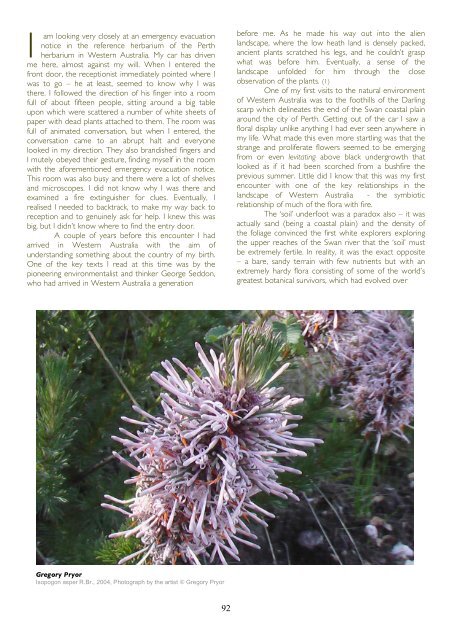M - Antennae The Journal of Nature in Visual Culture
M - Antennae The Journal of Nature in Visual Culture
M - Antennae The Journal of Nature in Visual Culture
Create successful ePaper yourself
Turn your PDF publications into a flip-book with our unique Google optimized e-Paper software.
I<br />
am look<strong>in</strong>g very closely at an emergency evacuation<br />
notice <strong>in</strong> the reference herbarium <strong>of</strong> the Perth<br />
herbarium <strong>in</strong> Western Australia. My car has driven<br />
me here, almost aga<strong>in</strong>st my will. When I entered the<br />
front door, the receptionist immediately po<strong>in</strong>ted where I<br />
was to go – he at least, seemed to know why I was<br />
there. I followed the direction <strong>of</strong> his f<strong>in</strong>ger <strong>in</strong>to a room<br />
full <strong>of</strong> about fifteen people, sitt<strong>in</strong>g around a big table<br />
upon which were scattered a number <strong>of</strong> white sheets <strong>of</strong><br />
paper with dead plants attached to them. <strong>The</strong> room was<br />
full <strong>of</strong> animated conversation, but when I entered, the<br />
conversation came to an abrupt halt and everyone<br />
looked <strong>in</strong> my direction. <strong>The</strong>y also brandished f<strong>in</strong>gers and<br />
I mutely obeyed their gesture, f<strong>in</strong>d<strong>in</strong>g myself <strong>in</strong> the room<br />
with the aforementioned emergency evacuation notice.<br />
This room was also busy and there were a lot <strong>of</strong> shelves<br />
and microscopes. I did not know why I was there and<br />
exam<strong>in</strong>ed a fire ext<strong>in</strong>guisher for clues. Eventually, I<br />
realised I needed to backtrack, to make my way back to<br />
reception and to genu<strong>in</strong>ely ask for help. I knew this was<br />
big, but I didn’t know where to f<strong>in</strong>d the entry door.<br />
A couple <strong>of</strong> years before this encounter I had<br />
arrived <strong>in</strong> Western Australia with the aim <strong>of</strong><br />
understand<strong>in</strong>g someth<strong>in</strong>g about the country <strong>of</strong> my birth.<br />
One <strong>of</strong> the key texts I read at this time was by the<br />
pioneer<strong>in</strong>g environmentalist and th<strong>in</strong>ker George Seddon,<br />
who had arrived <strong>in</strong> Western Australia a generation<br />
Gregory Pryor<br />
Isopogon asper R.Br., 2004, Photograph by the artist � Gregory Pryor<br />
92<br />
before me. As he made his way out <strong>in</strong>to the alien<br />
landscape, where the low heath land is densely packed,<br />
ancient plants scratched his legs, and he couldn’t grasp<br />
what was before him. Eventually, a sense <strong>of</strong> the<br />
landscape unfolded for him through the close<br />
observation <strong>of</strong> the plants. (1)<br />
One <strong>of</strong> my first visits to the natural environment<br />
<strong>of</strong> Western Australia was to the foothills <strong>of</strong> the Darl<strong>in</strong>g<br />
scarp which del<strong>in</strong>eates the end <strong>of</strong> the Swan coastal pla<strong>in</strong><br />
around the city <strong>of</strong> Perth. Gett<strong>in</strong>g out <strong>of</strong> the car I saw a<br />
floral display unlike anyth<strong>in</strong>g I had ever seen anywhere <strong>in</strong><br />
my life. What made this even more startl<strong>in</strong>g was that the<br />
strange and proliferate flowers seemed to be emerg<strong>in</strong>g<br />
from or even levitat<strong>in</strong>g above black undergrowth that<br />
looked as if it had been scorched from a bushfire the<br />
previous summer. Little did I know that this was my first<br />
encounter with one <strong>of</strong> the key relationships <strong>in</strong> the<br />
landscape <strong>of</strong> Western Australia - the symbiotic<br />
relationship <strong>of</strong> much <strong>of</strong> the flora with fire.<br />
<strong>The</strong> ‘soil’ underfoot was a paradox also – it was<br />
actually sand (be<strong>in</strong>g a coastal pla<strong>in</strong>) and the density <strong>of</strong><br />
the foliage conv<strong>in</strong>ced the first white explorers explor<strong>in</strong>g<br />
the upper reaches <strong>of</strong> the Swan river that the ‘soil’ must<br />
be extremely fertile. In reality, it was the exact opposite<br />
– a bare, sandy terra<strong>in</strong> with few nutrients but with an<br />
extremely hardy flora consist<strong>in</strong>g <strong>of</strong> some <strong>of</strong> the world’s<br />
greatest botanical survivors, which had evolved over












